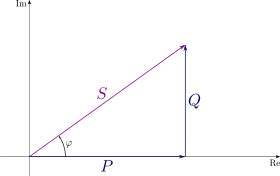Volt-ampere

A volt-ampere (VA) is the unit used for the apparent power in an electrical circuit, equal to the product of root-mean-square (RMS) voltage and RMS current.[1] In direct current (DC) circuits, this product is equal to the real power (active power) [2] in watts. Volt-amperes are useful only in the context of alternating current (AC) circuits (sinusoidal voltages and currents of the same frequency).
Some devices, including uninterruptible power supplies (UPSs), have ratings both for maximum volt-amperes and maximum watts. The VA rating is limited by the maximum permissible current, and the watt rating by the power-handling capacity of the device. When a UPS powers equipment which presents a reactive load with a low power factor, neither limit may safely be exceeded.[3] For example, a (large) UPS system rated to deliver 400,000 volt-amperes at 220 volts can deliver a current of 1818 amperes.
The convention of using the volt-ampere to distinguish apparent power from real power is not supported by the SI standard, which prohibits using unit symbols to "provide specific information" about a quantity.[4]
See also
References
- ↑ Ciletti, M. D., Irwin, J. D., Kraus, A. D., Balabanian, N., Bickard, T. A., and Chan, S. P. (1993). Linear circuit analysis. In Electrical Engineering Handbook, edited by R. C. Dorf. Boca Raton: CRC Press. (pp.82–87)
- ↑ IEEE 100 : the authoritative dictionary of IEEE standards terms.-7th ed. ISBN 0-7381-2601-2, page 23
- ↑ Watt Ratings Differs From Volt Amp Ratings APC
- ↑ SI Brochure, 8th ed.: "Just as the quantity symbol should not imply any particular choice of unit, the unit symbol should not be used to provide specific information about the quantity […]" Section 5.3.2.